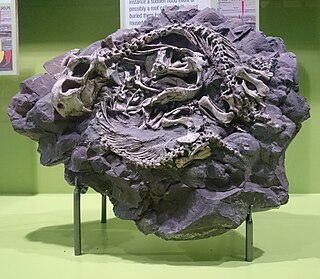
Dicynodontia is an extinct clade of anomodonts, an extinct type of non-mammalian therapsid. Dicynodonts were herbivores that typically bore a pair of tusks, hence their name, which means 'two dog tooth'. Members of the group possessed a horny, typically toothless beak, unique amongst all synapsids. Dicynodonts first appeared in Southern Pangaea during the mid-Permian, ca. 270–260 million years ago, and became globally distributed and the dominant herbivorous animals in the Late Permian, ca. 260–252 Mya. They were devastated by the end-Permian Extinction that wiped out most other therapsids ca. 252 Mya. They rebounded during the Triassic but died out towards the end of that period. They were the most successful and diverse of the non-mammalian therapsids, with over 70 genera known, varying from rat-sized burrowers to elephant-sized browsers.

Wadiasaurus is an extinct genus of dicynodont from the family Kannemeyeria, that lived in herds from the early to Middle Triassic. Substantial fossorial evidence of W. indicus was recovered from Yerrapalli Formation of the Pranhita-Godavari valley, India, and it is so far the only Kannemeyeriid known for certain from India. The Kannemeyeriiformes underwent a significant diversification during the middle Triassic, with roughly 40 known species distributed worldwide. All Kannemeyeriiformes were medium to large bodied, graviportal herbivores with relatively erect posture and gait. Wadiasaurus indicus is currently the only known species of Wadiasaurus.

Moghreberia is an extinct genus of dicynodont predicted to have lived only in the mid-Triassic, primarily during the early middle Carnian and found only in the Argana Basin of Morocco. Moghreberia belonged to the Stahleckeriidae family, a group of anomodont therapsids and is most commonly known by its species Moghreberia nmachouensis. Its name is derived from the Arabic phrase al-Maghrib al-Aqsa meaning “the far west”, a term used by Arabic scholars to refer to the approximate region of Morocco, the area in which this animal’s fossil was first discovered. The extinction of many dicynodonts has been attributed to pressures of the Carnian Pluvial Episode, which occurred around 234-232 Ma and generated major ecological and climate changes for years to come.

Myosaurus is a genus of dicynodont synapsids. Myosaurus was a small, herbivorous synapsid that existed around the early Triassic period. All of the fossils found of this species were found in Antarctica and South Africa. Compared to other fossils found from species that existed during this time, the Myosaurus is not common in the fossil record. This is due to a shortage of discovered fossils that possess characteristics unique to the Myosaurus. Notably, under 130 fossil fragments have been found that have been classified as Myosauridae, and almost all have been skulls. These skulls can be classified as Myosaurus because this species, unlike other dicynodonts, do not possess tusks or postfrontal teeth. The only species identified in the family Myosauridae is the Myosaurus gracilis, or M. gracilis. It should be recognized that the Myosaurus is almost always referred to as the M. gracilis in scientific research.
Angonisaurus is an extinct genus of kannemeyeriiform dicynodont from the Middle Triassic of Africa between 247 and 242 million years ago. Only one species, Angonisaurus cruickshanki has been assigned to this genus. This genus is thought to have been widely spread but rare in southern Gondwana. Though few in number, the fossil record of Angonisaurus cruickshanki contains multiple specimens giving it a measurable stratigraphic range. Sexually dimorphic features are found in Angonisaurus which include presence or absence of tusks and difference is size and robustness of the temporal arch and the rostral.

Biseridens is an extinct genus of anomodont therapsid, and one of the most basal anomodont genera known. Originally known from a partial skull misidentified as an eotitanosuchian in 1997, another well-preserved skull was found in the Qingtoushan Formation in the Qilian Mountains of Gansu, China, in 2009 that clarified its relationships to anomodonts, such as the dicynodonts.
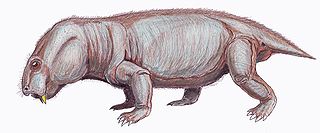
Dicynodontoides is a genus of small to medium-bodied, herbivorous, emydopoid dicynodonts from the Late Permian. The name Dicynodontoides references its “dicynodont-like” appearance due to the caniniform tusks featured by most members of this infraorder. Kingoria, a junior synonym, has been used more widely in the literature than the more obscure Dicynodontoides, which is similar-sounding to another distantly related genus of dicynodont, Dicynodon. Two species are recognized: D. recurvidens from South Africa, and D. nowacki from Tanzania.

Odontocyclops is an extinct genus of Dicynodonts that lived in the Late Permian. Dicynodonts are believed to be the first major assemblage of terrestrial herbivores. Fossils of Odontocyclops have been found in the Karoo Basin of South Africa and the Luangwa Valley of Zambia. The phylogenetic classification of Odontocyclops has been long under debate, but most current research places them as their own genus of Dicynodonts and being very closely related to Rhachiocephalus and Oudenodon.
Sangusaurus is an extinct genus of large dicynodont synapsid with two recognized species: S. edentatus and S. parringtonii. Sangusaurus is named after the Sangu stream in eastern Zambia near to where it was first discovered + ‘saur’ which is the Greek root for lizard. Sangusaurus fossils have been recovered from the upper parts of the Ntawere Formation in Zambia and of the Lifua Member of the Manda Beds in Tanzania. The earliest study considered Sangusaurus a kannemeyeriid dicynodont, but more recent phylogenetic analyses place Sangusaurus within the stahleckeriid clade of Dicynodontia. Until recently, little work had been done to describe Sangusaurus, likely due to the fact that only four incomplete fossil specimens have been discovered.

Tetragonias is an extinct genus of dicynodont from the Anisian Manda Beds of Tanzania. With tetra meaning “four,” and goni meaning “angle,” the name references the square shape of the Tetragonias skull when viewed dorsally. Not to be confused with the plant Tetragonia,Tetragonias were dicynodont anomodonts discovered in the late 1960s by paleontologist A. R. I. Cruickshank in the Manda Formation. Only the type species, T. njalilus, has been recognized.
Zambiasaurus is an extinct genus of dicynodonts that was discovered in the Middle Triassic (Anisian) Ntawere Formation of Zambia, southern Africa. It was a large dicynodont, reconstructed using several fossil fragments, in majority belonging to probably a juvenile Zambiasaurus submersus.

Kombuisia is a genus of dicynodont from Early to Middle Triassic of South Africa and Antarctica. Two species were described for the genus: Kombuisia frerensis (type) and Kombuisia antarctica.

Smok is an extinct genus of large carnivorous archosaur. It lived during the latest Triassic period. Its remains have been found in Lisowice, southern Poland. The only species is Smok wawelski and was named in 2012. It is larger than any other known predatory archosaur from the Late Triassic or Early Jurassic of central Europe. The relation of Smok to other archosaurs has not yet been thoroughly studied; it may be a rauisuchid, prestosuchid, an ornithosuchid pseudosuchian or a theropod dinosaur.

Pentasaurus is an extinct genus of dicynodont of the family Stahleckeriidae, closely related to the well known Placerias. It was found in the Lower Elliot Formation of South Africa, dated to the Norian of the Late Triassic period. The genus contains the type and only species, Pentasaurus goggai. Pentasaurus is named after the ichnogenus Pentasauropus, fossil footprints that were originally described from the lower Elliot Formation in 1970 decades before the body fossils of Pentasaurus itself were recognised. Pentasauropus footprints were likely made by dicynodonts, and in South Africa Pentasaurus itself was the likely trackmaker. The name reflects the fact that a large dicynodont was predicted to have existed in the lower Elliot Formation before any body fossils were recognised, and so Pentasaurus was named after its probable footprints. This is a reversal of the more typical occurrence where fossil footprints are named after their presumed trackmakers. The name of the species honours its collector Alfred Brown, nicknamed "Gogga", which means "bug" in Afrikaans.

Lisowicia is an extinct genus of giant dicynodont synapsid that lived in what is now Poland during the late Norian or earliest Rhaetian age of the Late Triassic Period, about 210–205 million years ago. Lisowicia is the largest known dicynodont, as well as the largest non-mammalian synapsid, reaching about 4.5 metres (15 ft) long, standing up to 2.6 metres (8.5 ft) tall at the hips and weighing around 5–7 metric tons, comparable in size to modern elephants. It was also one of the last dicynodonts, living shortly before their extinction at the end of the Triassic period. Fossils of a giant dicynodont were known from Poland since 2008, but Lisowicia was not named and officially described as a new species until late 2018.
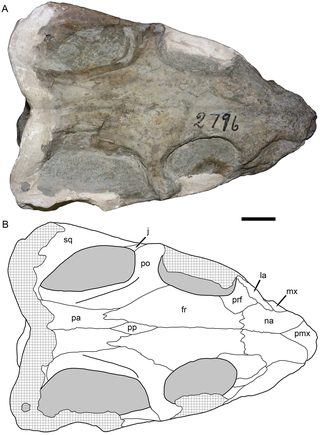
Thliptosaurus is an extinct genus of small kingoriid dicynodont from the latest Permian period of the Karoo Basin in KwaZulu-Natal, South Africa. It contains the type and only known species T. imperforatus. Thliptosaurus is from the upper Daptocephalus Assemblage Zone, making it one of the youngest Permian dicynodonts known, living just prior to the Permian mass extinction. It also represents one of the few small bodied dicynodonts to exist at this time, when most other dicynodonts had large body sizes and many small dicynodonts had gone extinct. The unexpected discovery of Thliptosaurus in a region of the Karoo outside of the historically sampled localities suggests that it may have been part of an endemic local fauna not found in these historic sites. Such under-sampled localities may contain 'hidden diversities' of Permian faunas that are unknown from traditional samples. Thliptosaurus is also unusual for dicynodonts as it lacks a pineal foramen, suggesting that it played a much less important role in thermoregulation than it did for other dicynodonts.

Counillonia is an extinct genus of dicynodont therapsid from the area of Luang Prabang in Laos, Southeast Asia that lived at around the time of the Permian-Triassic boundary and possibly dates to the earliest Early Triassic. Its type and only known species is C. superoculis. Counillonia was related to the Triassic dicynodonts such as Lystrosaurus and the Kannemeyeriiformes that survived the Permian mass extinction, but it was more closely related to the Permian genus Dicynodon than to either of these lineages. Counillonia may then possibly represent another line of dicynodonts that survived the Permian mass extinction into the Triassic period, depending on its age. The discovery of Counillonia in Laos and its unexpected evolutionary relationships hint at the less well understood geographies of dicynodont diversity across the Permo-Triassic boundary outside of well explored regions like the Karoo Basin in South Africa.
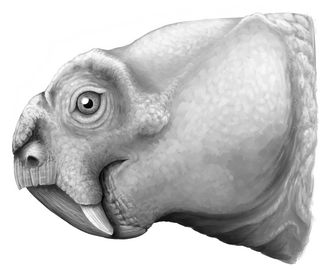
Repelinosaurus is an extinct genus of dicynodont from the Purple Claystone Formation of Luang Prabang in Laos, Southeast Asia that lived at around the time of the Permian-Triassic boundary and possibly dates to the earliest Early Triassic. Its type and only known species is R. robustus. Repelinosaurus was originally described as the earliest known kannemeyeriiform dicynodont, supporting the idea of a more rapid radiation of the Triassic kannemeyeriiform dicynodonts during the Early Triassic following the Permian mass extinction. However, it may alternatively be more closely related to the Permian Dicynodon. The discovery of a potential early kannemeyeriiform in an understudied locality like Laos highlights the importance of such places in dicynodont research, which has been largely focused on historically important localities such as the Karoo Basin of South Africa.
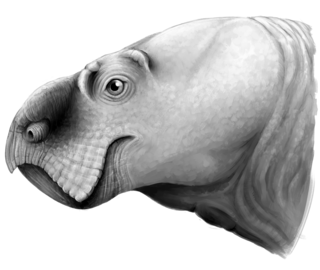
Ufudocyclops is an extinct genus of stahleckeriid dicynodont from the Middle Triassic of South Africa. It was found in the Burgersdorp Formation, part of the uppermost Cynognathus Assemblage Zone of the Beaufort Group in the Karoo Basin. The type and only known species is U. mukanelai. It was a large, beaked herbivore like other Triassic dicynodonts, lacking tusks, and is mostly characterised by unique features of the skull. It is known from three specimens, two of which were previously referred to the Tanzanian dicynodont Angonisaurus. The separation of Ufudocyclops from Angonisaurus indicates that the Middle Triassic fauna of the Beaufort Group in South Africa was not part of a larger shared fauna with those of the Manda Beds in Tanzania, as was previously supposed, and suggests that they were separated as more localised faunas, possibly by geographic barriers or in time. Ufudocyclops then would have been a unique part of the uppermost Cynognathus Assemblage Zone in South Africa. It is also the oldest known member of the family Stahleckeriidae, and implies that the family was already diversifying in the Middle Triassic alongside other kannemeyeriiforms, not just in the Late Triassic after other families died out.
Taoheodon is an extinct genus of dicynodont therapsid from the Sunjiagou Formation in the Shanxi province of China, dated to the Wuchiapingian age of the Late Permian. Its type and only known species is T. baizhijuni. Taoheodon was a close relative of the well known Dicynodon, and may represent a biogeographical link between the South African Dicynodon and similar dicynodonts found in Laos.





















